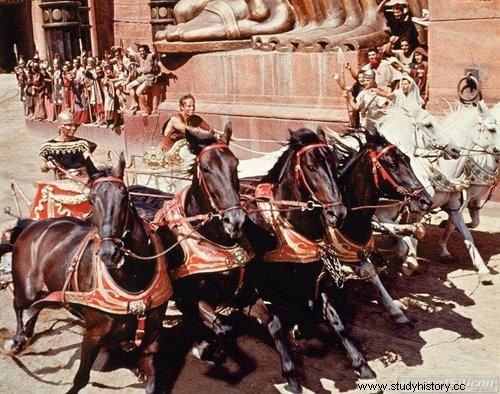The chariot races of ancient Rome would be equivalent to today's Formula 1. As we anticipated in the previous post, in which you can consult certain technical aspects (, we have the story of one of them extracted from VALENTIA, Las Memorias de Cayo Antonio Naso :
A sonorous fanfare to the sound of horns and fifes announced the arrival of the well-dressed authorities guarded by a conspiracy of local militiamen and a kind of lictors who gave the ensemble an imperial touch with a certain provincial flavor. Once the dignitaries were accommodated, the parade began, leaving the Porta Pompae with the participants of the races. Through the high arches two light beams appeared in the foreground in which two criers, neatly dressed, announced the imminent appearance of the heroes of the afternoon and their sponsors. Immediately afterwards, the acclaimed chariots of Lisandro, Crisus and two other charioteers burst into the arena, completing the four colors with which the public identified until the riot and with which the felony bookmakers did their fat business every racing day. .
The beautiful Crisus, that year's champion, dressed like a mirmillion but sporting a small helm with a narrow, shaggy red crest instead of the typical hammered helmet, was the champion of the Red. He rode a beautiful, curvaceous chariot, light but robust, painted in brilliant vermilion and topped with gilt harness, which four black steeds drove as smoothly as if sliding across sheets of ice.
His opponent and contender for victory, the young Lysander, dressed in elegant Greek clothes in the pure style of Achilles, tight leather cap and whip in hand, the defender of White, was not far behind. He rode on a slender chariot pearly and adorned on its sides with an abundant silver cornucopia on six crossed spears, the symbol of the city, whose brightness when exposed to the inclement rays of the sun blinded some spectators for an instant. Four white mares with straight gray manes made up the team of the impressive chariot.
The rest of the participants, two charioteers with less impact in the gambling dens, also wore worked leather breastplates and chariots, which, not because they were less luxurious, did not seem simpler. And no less lustrous were the bay horses that dragged them. They were the champions of Green and Blue, the usual colors of the Army and the Senate that were obviously not very popular outside the circles of power in the City.
The four charioteers headed towards the center of the track, stopping halfway down the spine, in front of the authorities' box. From Tito's privileged position, the Antonia family could see the reflection of the polished rivets of the suits, the reflections of the cars and the sweat of the donkeys as if they were right next to them. After requesting permission from the authorities, the four drivers, rein in the right hand, whip in the opposite and wearing a helmet, were waiting for the duumviro to release the white cloth from the balcony of the pulvinar indicating with it the start of the seven laps that the daring charioteers should do.
The support staff, after thoroughly raking the beaten earth of the track, was ready on the steps of the spina, a small wall a little over six feet high that formed the axis of the racecourse on which the cars had to turn . […] The brawny Nubian slaves tasked with turning the Septem Ova each completed turn were ready, the priest of Jupiter had performed the appropriate auspices successfully, and the stable attendants and infirmary attendants were ready and at their posts. The long-awaited moment had arrived. Once again, the great show of the Ludus Máximus could begin.
And the mappa fell from the hand of the duumvir on duty while the pretentious Quintus Gabinius boasted of the great chariot race with which he intended to entertain his next electorate. And seeing the vaporous white cloth fall from the hand of the chief magistrate of the city, the charioteers cracked their whips on the backs of the rearing steeds that tore off like furies amid the shouting of the public and a superb cloud of dust. The followers of the different colors could be recognized in the stands since people used to dress on such days in tone with the colors of their bet.

Chariot race. Ben-Hur
Lisandro snatched the lead on the first lap from Crisus, who lost part of the short track by opening up too much in the second corner, a mistake that the young contender took advantage of without hesitation. This is how three more laps went on in an environment that was increasingly bristling with tension, heat and the intense cloud of dust caused by the sharp gallop of the horses. The charioteers whipped their steeds mercilessly, encouraged by the cries of their respective followers. They competed absent from the rest of the world, concentrating on each passum they traveled at such great speed. One of the other less popular charioteers, the one in third place, collided with Crisus's wheels at the Porta Triumphalis corner on lap four. He lost control of his chariot and fell face down to the dusty ground just in time to deftly crawl to the shelter of the thorn and thus save himself from a horrible certain death kicked by the horses of his immediate pursuer […]
